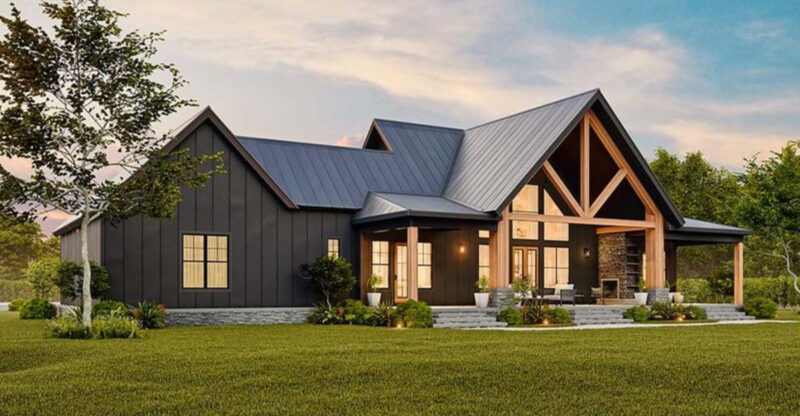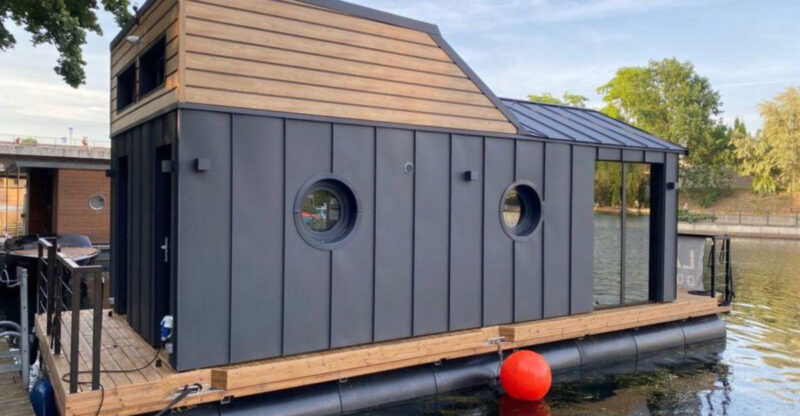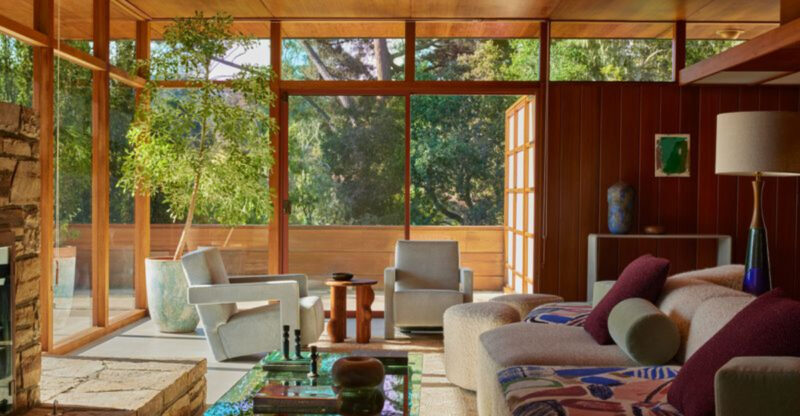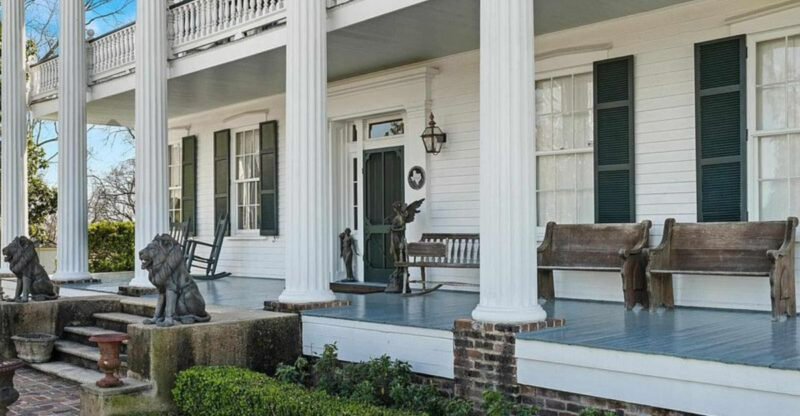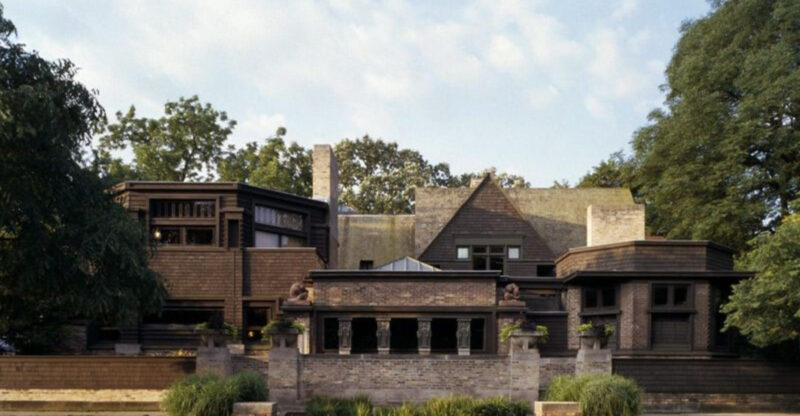Explore 16 Historic Brick Mansions Constructed By America’s Legendary Wealthy Families
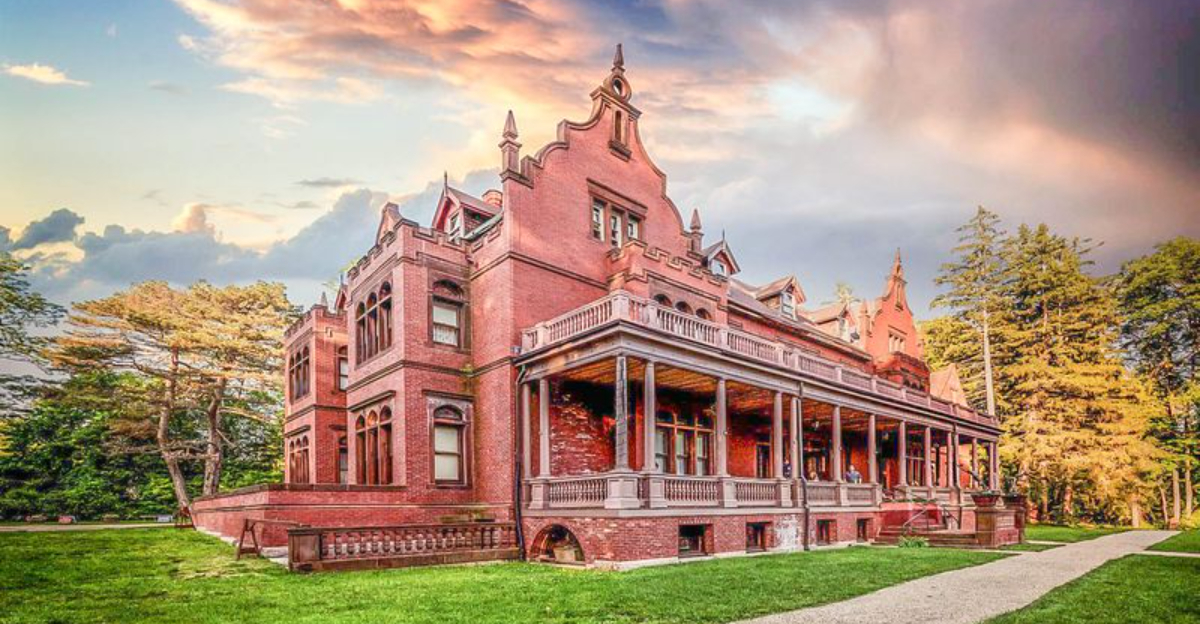
America’s Gilded Age saw immense fortunes create architectural wonders that still amaze us today.
Wealthy industrialists and financiers competed to build the most magnificent brick mansions as symbols of their success and taste.
These stunning homes, now mostly open to the public, offer glimpses into a bygone era of unprecedented luxury and craftsmanship that shaped our nation’s architectural legacy.
1. Biltmore Estate – Vanderbilt Family, Asheville, NC
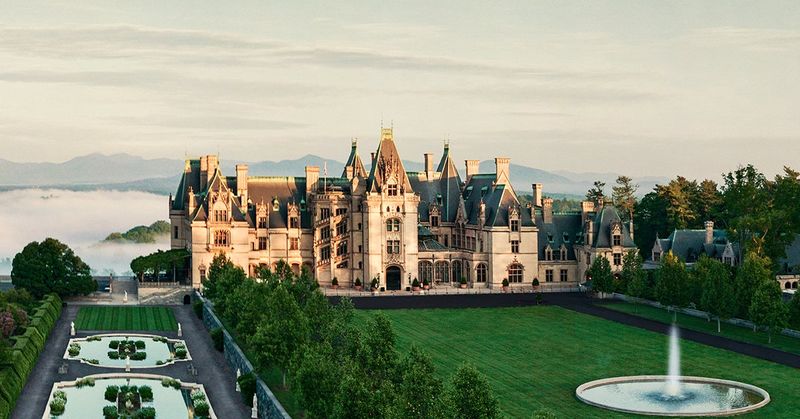
George Vanderbilt’s mountain retreat remains America’s largest private home, boasting 250 rooms spread across 175,000 square feet. Built in 1895, this architectural marvel showcases Richard Morris Hunt’s design genius with its distinctive red brick and limestone exterior.
Inside, visitors discover priceless art, vintage clothing, and antique furniture amid rooms designed for lavish entertaining. The surrounding 8,000-acre estate features gardens designed by Frederick Law Olmsted.
Workers quarried limestone on the property while importing marble from Italy and wood from exotic locations worldwide. Today, the estate welcomes visitors year-round, with spectacular Christmas decorations making winter visits particularly magical.
2. The Breakers – Vanderbilt Family, Newport, RI
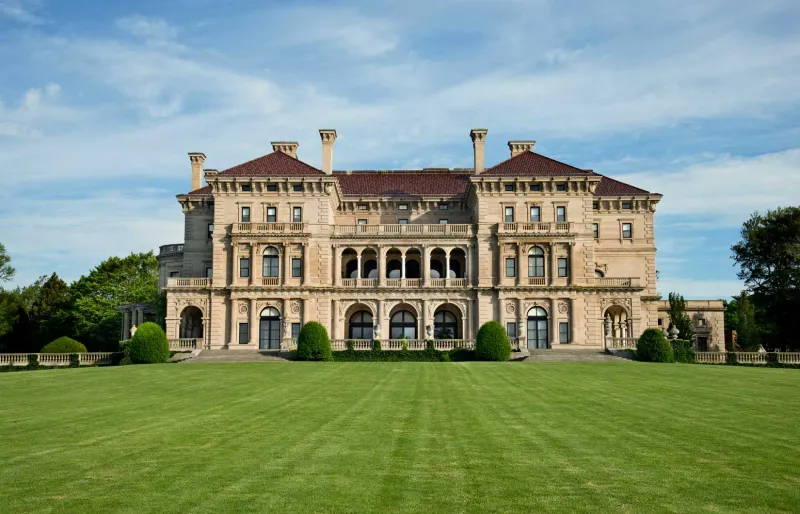
Perched dramatically on the Atlantic coastline, The Breakers exemplifies the opulence of America’s Gilded Age. Cornelius Vanderbilt II commissioned architect Richard Morris Hunt to create this 70-room Italian Renaissance-style palazzo after the original wooden structure burned down in 1892.
The mansion’s façade combines brick with imported limestone, while the interior dazzles with precious metals, rare marbles, and mosaic tile ceilings. Each room tells stories of lavish parties where America’s elite gathered during Newport’s summer season.
My favorite feature is the Morning Room, with its platinum leaf wall panels and breathtaking ocean views. Remarkably, descendants of the Vanderbilt family occupied The Breakers until 1948 before it opened to the public.
3. Kykuit – Rockefeller Family, Sleepy Hollow, NY
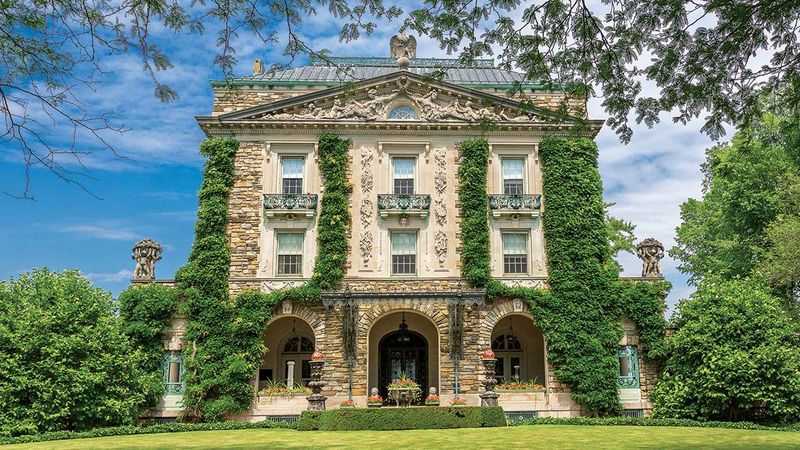
Hidden among rolling hills overlooking the Hudson River stands Kykuit, the six-story brick fortress that housed four generations of Rockefellers. John D. Rockefeller, once the world’s richest man, began this elegant residence in 1913, though his son Junior later expanded and refined it.
The name “Kykuit” means “lookout” in Dutch, perfectly describing its commanding position with sweeping views toward Manhattan. Unlike other Gilded Age showplaces, this mansion balances grandeur with restrained taste, featuring classical architecture and gardens inspired by European designs.
Art lovers appreciate the basement gallery housing Nelson Rockefeller’s modern art collection, including works by Picasso and Warhol. The grounds contain remarkable fountains, classical sculptures, and a coach barn housing antique automobiles and horse-drawn carriages.
4. Dumbarton Oaks – Bliss Family, Washington, D.C.
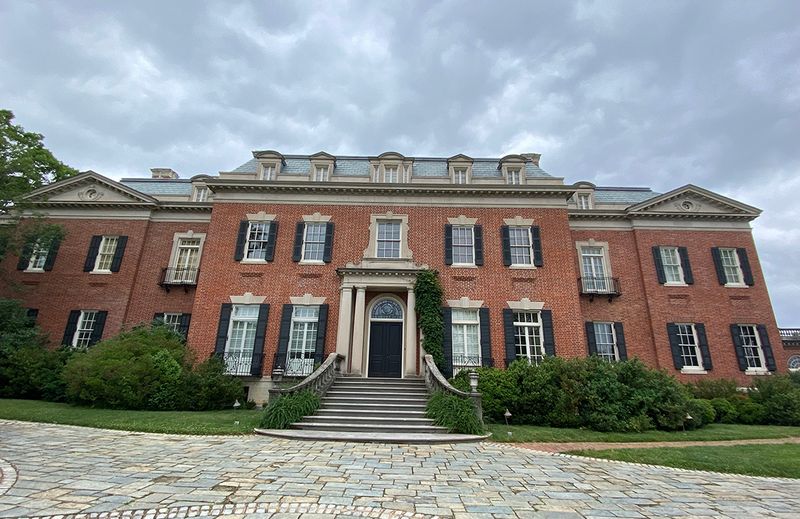
Tucked away in Georgetown’s historic district, Dumbarton Oaks represents a perfect marriage of architectural elegance and intellectual purpose. Robert and Mildred Bliss purchased this Federal-style brick mansion in 1920, transforming it into a sophisticated center for Byzantine and Pre-Columbian art study.
Though smaller than many Gilded Age mansions, what Dumbarton Oaks lacks in size it makes up for in cultural significance. The historic 1944 conference that helped establish the United Nations took place in its Music Room.
Are you a garden enthusiast? The terraced landscape designed by pioneering female landscape architect Beatrix Farrand remains one of America’s most significant garden designs, featuring intimate outdoor “rooms” connected by paths and stairs. The estate now belongs to Harvard University, which maintains its research libraries and museum collections.
5. Hillwood Estate – Post Family, Washington, D.C.
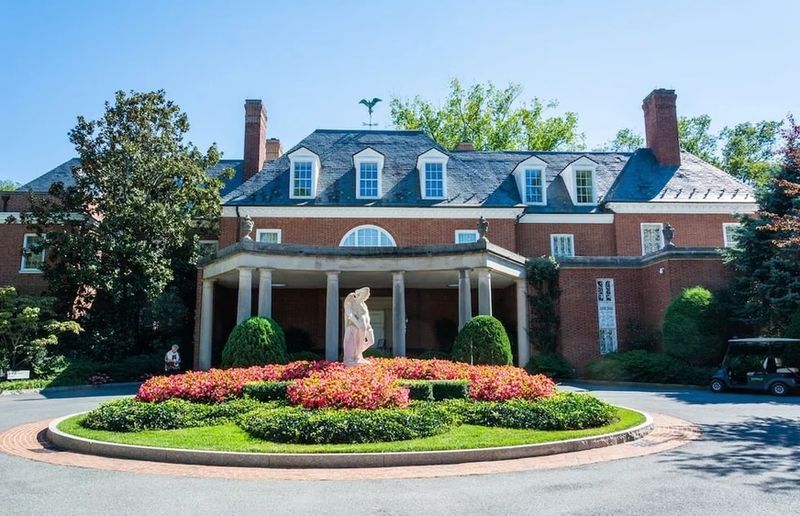
Marjorie Merriweather Post, heiress to the Post cereal fortune, created this magnificent Georgian-style brick mansion as her spring and fall residence in 1955. Unlike older Gilded Age mansions, Hillwood specifically showcases Post’s extraordinary passion for collecting Russian imperial art – the most comprehensive collection outside Russia.
Walking through the 36-room mansion feels like entering a museum where someone actually lived. The breakfast room’s Sèvres porcelain and the iconostasis in her private chapel demonstrate Post’s exquisite taste and deep pockets.
The estate’s 13 acres of formal gardens include a Japanese-style garden, rose garden, and French parterre. Post stipulated that Hillwood become a museum after her death, fulfilling her desire to share her collections with the American public while preserving her elegant lifestyle.
6. Vizcaya Museum and Gardens – Deering Family, Miami, FL
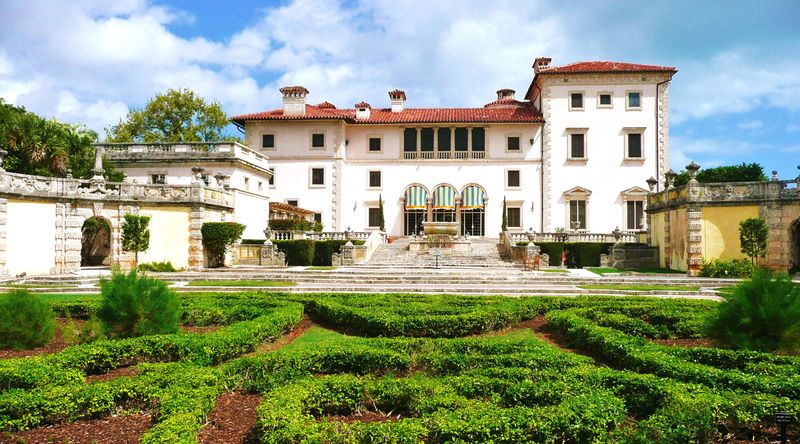
James Deering, heir to the International Harvester fortune, created this Mediterranean fantasy along Biscayne Bay between 1914 and 1922. Unlike the northern brick mansions, Vizcaya combines brick structural elements with coral stone cladding, creating a distinctly Floridian interpretation of Italian Renaissance design.
The 34-room main house surrounds a central courtyard, protecting it from Miami’s intense sun and tropical storms. Artisans from Europe crafted the elaborate interiors, incorporating architectural elements from actual Renaissance buildings Deering purchased abroad.
Vizcaya’s formal gardens blend Italian design with tropical plants, creating stunning vistas that end at the famous Stone Barge in the bay. Hurricane damage has repeatedly threatened this treasure, yet careful restoration has preserved what many consider America’s finest example of Mediterranean Revival architecture.
7. Nemours Estate – du Pont Family, Wilmington, DE
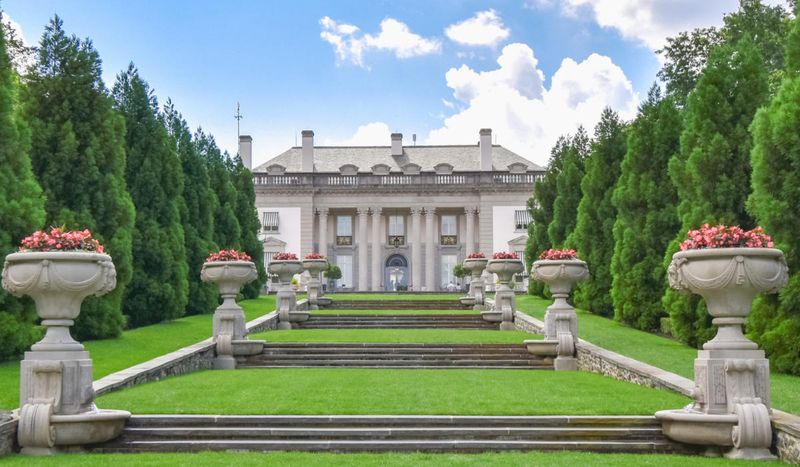
Alfred I. du Pont built this spectacular 77-room Louis XVI-style chateau for his second wife, Alicia, in 1909. The mansion’s brick core is faced with imported limestone, creating one of America’s finest examples of formal French architecture and landscape design.
Nemours takes its name from the du Pont family’s ancestral home in France. The mansion’s grandest feature is the Long Gallery, modeled after Versailles’ Hall of Mirrors, where crystal chandeliers reflect light across marble floors and gilded moldings.
Did you know the estate contains the largest formal French gardens in North America? The 300-acre grounds feature a one-acre reflecting pool, maze garden, and 23-karat gold-leafed statues. After Alfred’s death, the estate became the Nemours Foundation, supporting the adjacent children’s hospital he established with his fortune.
8. Winterthur – du Pont Family, Wilmington, DE
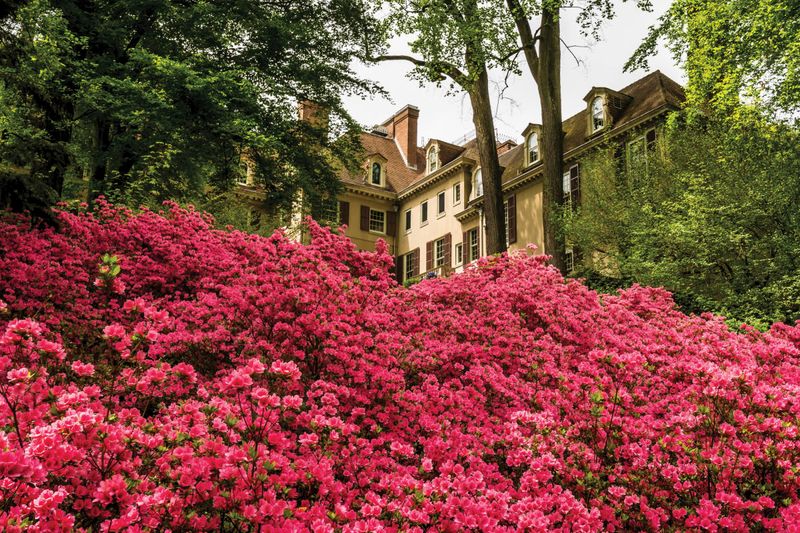
Henry Francis du Pont transformed his childhood home into America’s premier museum of decorative arts, expanding the original brick mansion to 175 rooms. Unlike other du Pont estates, Winterthur emphasizes American craftsmanship rather than European grandeur, housing 90,000 objects made or used in America between 1640 and 1860.
The mansion evolved organically as du Pont’s collection grew, with rooms designed specifically to showcase period furniture, textiles, and ceramics. What makes Winterthur unique is how du Pont arranged each room as a cohesive artwork, considering how light, color, and texture work together.
The surrounding 1,000-acre estate features naturalistic gardens influenced by du Pont’s horticultural expertise. Particularly famous is the March Bank, where thousands of snowdrops, crocuses, and glory-of-the-snow create breathtaking spring displays beneath ancient trees.
9. Fair Lane – Ford Family, Dearborn, MI
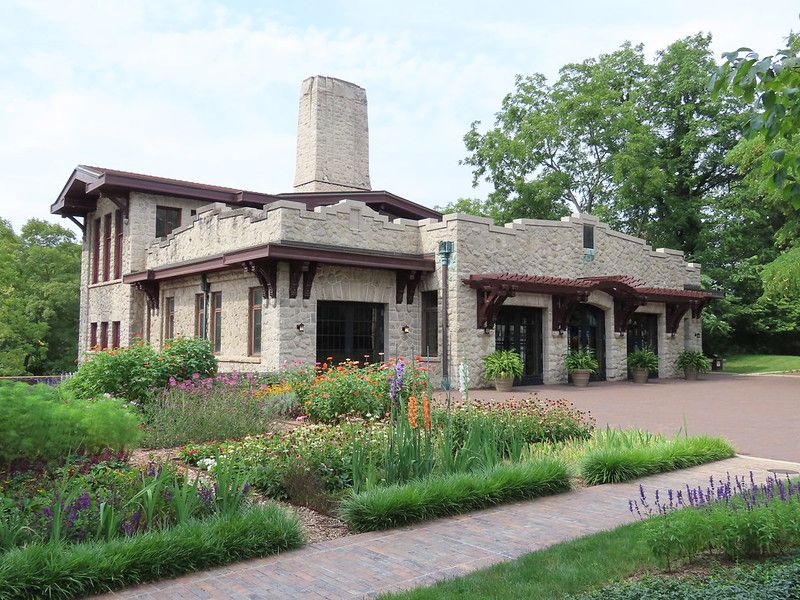
Henry and Clara Ford built their understated yet innovative brick manor house along the Rouge River in 1915, creating a home that reflected their practical Midwestern values. Though Ford could afford any luxury, Fair Lane’s 56 rooms emphasize comfort and cutting-edge technology rather than ostentation.
The mansion functioned as a self-sufficient power plant, generating its own hydroelectric power decades before sustainability became fashionable. Ford’s fascination with innovation appears throughout from the indoor swimming pool to an early home elevator and intercommunication system.
Clara’s gardens contrast with the home’s pragmatic design, featuring romantic landscape elements and a beautiful rose garden. After the Fords’ deaths, the estate became part of the University of Michigan before transitioning to its current status as an independent historic site undergoing extensive restoration.
10. Stan Hywet Hall – Seiberling Family, Akron, OH
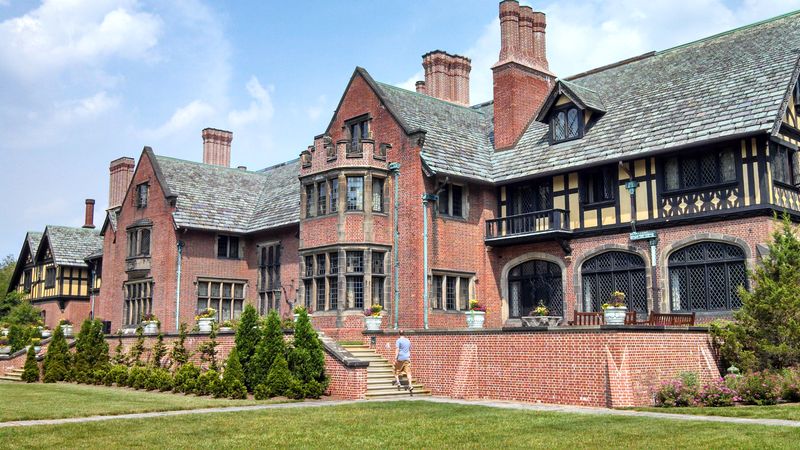
F.A. Seiberling, co-founder of Goodyear Tire & Rubber Company, created this Tudor Revival masterpiece between 1912 and 1915. The name “Stan Hywet” means “stone quarry” in Old English, referencing the property’s former use before becoming America’s 6th largest historic home.
The 65-room brick and sandstone mansion draws inspiration from English country estates, particularly those from the Elizabethan and Stuart periods. Architects designed the house to appear centuries old despite its modern amenities, using aged materials and traditional craftsmanship.
When exploring the grounds, don’t miss the Japanese Garden, English Garden, and Great Garden – all designed by renowned landscape architect Warren Manning. The Seiberling family showed remarkable foresight by establishing a non-profit in 1957 to preserve the estate for public enjoyment, ensuring this Midwestern architectural treasure remains accessible to all.
11. Lyndhurst Mansion – Gould Family, Tarrytown, NY
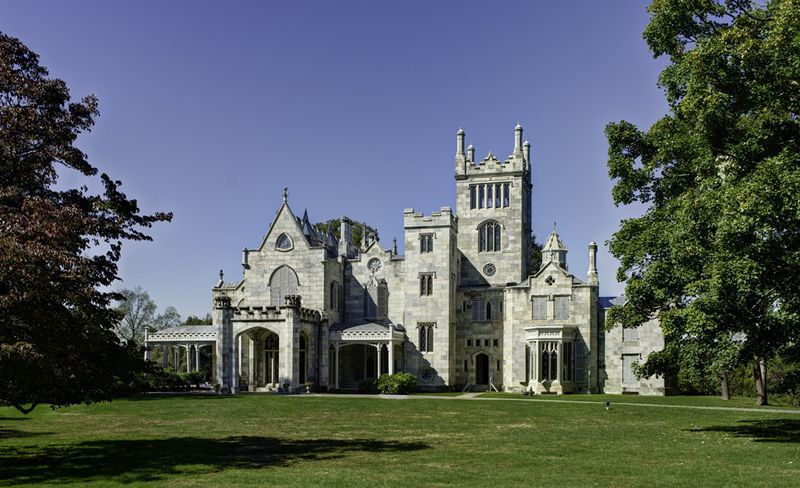
Perched dramatically above the Hudson River, Lyndhurst represents America’s finest Gothic Revival country house. Though initially built in 1838 for former New York City mayor William Paulding, railroad tycoon Jay Gould’s ownership from 1880 to 1892 defined its legacy.
The mansion’s distinctive red brick and limestone trim create a castle-like silhouette against the landscape. Inside, pointed arches, vaulted ceilings, and intricate woodwork emphasize the Gothic theme throughout its 67 rooms.
Gould’s daughter Helen maintained the estate until 1961, preserving original furnishings that span 175 years of American design history. The 67-acre grounds designed by Ferdinand Mangold include sweeping lawns, a remarkable rose garden, and America’s first steel-framed conservatory. Lyndhurst’s dramatic architecture has made it a favorite Hollywood filming location for Gothic-themed productions.
12. Marble House – Vanderbilt Family, Newport, RI
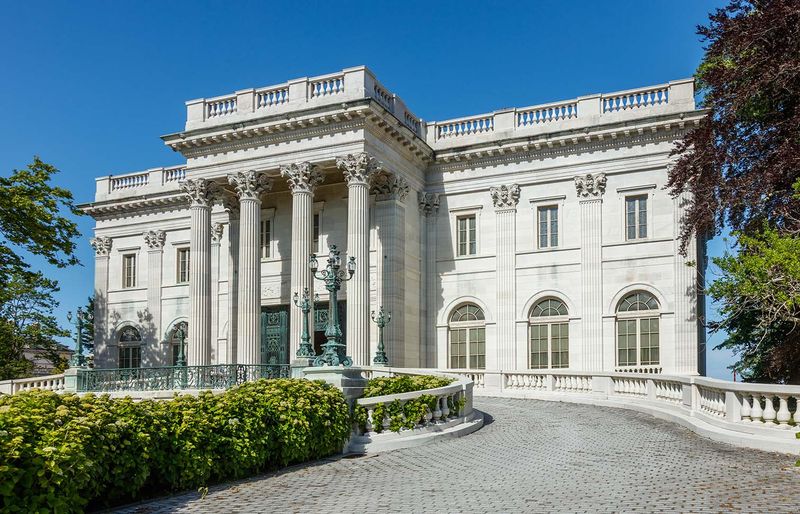
William K. Vanderbilt gifted this opulent “cottage” to his wife Alva for her 39th birthday in 1892, spending $11 million ($332 million today) on what became a revolution in Newport architecture. Despite its name, Marble House actually combines brick structural elements with 500,000 cubic feet of marble cladding, creating an impression of solid stone.
Architect Richard Morris Hunt modeled the mansion after the Petit Trianon at Versailles, though the interiors surpass even French royal splendor. The Gold Ballroom alone contains more than 22-karat gold leaf worth millions.
Alva Vanderbilt later divorced William and used Marble House to host women’s suffrage rallies in the early 1900s. The Chinese Tea House on the seaside cliff remains one of Newport’s most photographed structures, combining Eastern and Western architectural elements in a stunning oceanfront setting.
13. Oheka Castle – Kahn Family, Huntington, NY
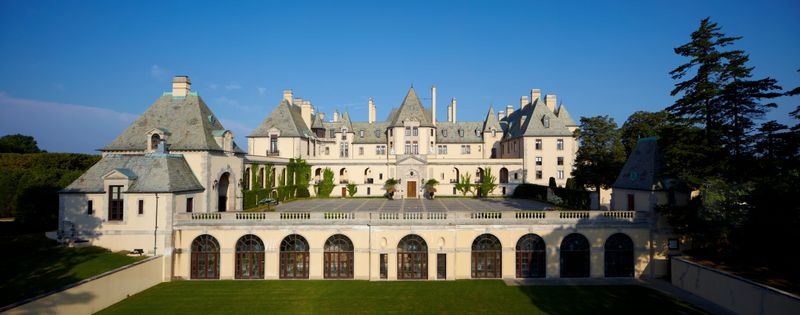
Financier Otto Hermann Kahn built America’s second-largest private home as his summer residence in 1919, creating a 127-room chateau on Long Island’s highest point. The name “Oheka” derives from Kahn’s initials, reflecting the personal vision behind this massive French-inspired brick mansion.
Kahn specifically designed the estate to be fireproof after his previous home burned down. The brick construction includes steel reinforcement and concrete floors innovative features for the era.
During Kahn’s lifetime, Oheka hosted legendary parties where Hollywood stars mingled with royalty and political figures. After decades of abandonment and vandalism following Kahn’s death, developer Gary Melius rescued the crumbling mansion in the 1980s. Today, Oheka operates as a luxury hotel and popular wedding venue, with Taylor Swift’s “Blank Space” music video showcasing its restored grandeur to modern audiences.
14. Ventfort Hall – Morgan Family, Lenox, MA
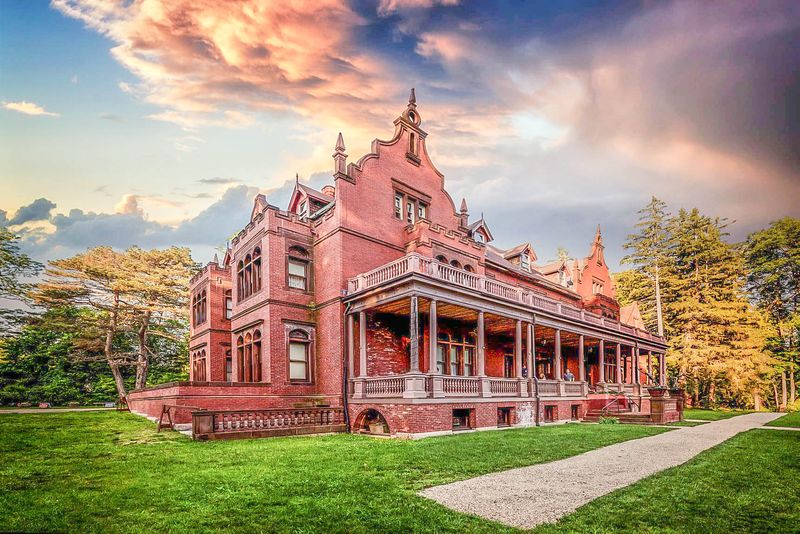
Sarah Morgan, sister of financial titan J.P. Morgan, commissioned this impressive Jacobean Revival mansion as her summer “cottage” in the Berkshires in 1893. The 28,000-square-foot red brick and sandstone structure cost $900,000 (equivalent to $28 million today).
Ventfort Hall’s most striking feature is its grand curved staircase rising through three stories beneath a stained glass skylight. The mansion contains 50 rooms, including a ballroom where the Morgans entertained fellow Gilded Age elites during the Berkshires’ summer season.
After decades serving as a dormitory, ballet school, and hotel, the mansion fell into severe disrepair by the 1990s. Local preservationists formed a trust to save it from demolition. Though restoration continues today, Ventfort Hall now houses the Museum of the Gilded Age, celebrating the era when America’s wealthiest families transformed Lenox into their summer playground.
15. Arden House – Harriman Family, Harriman, NY
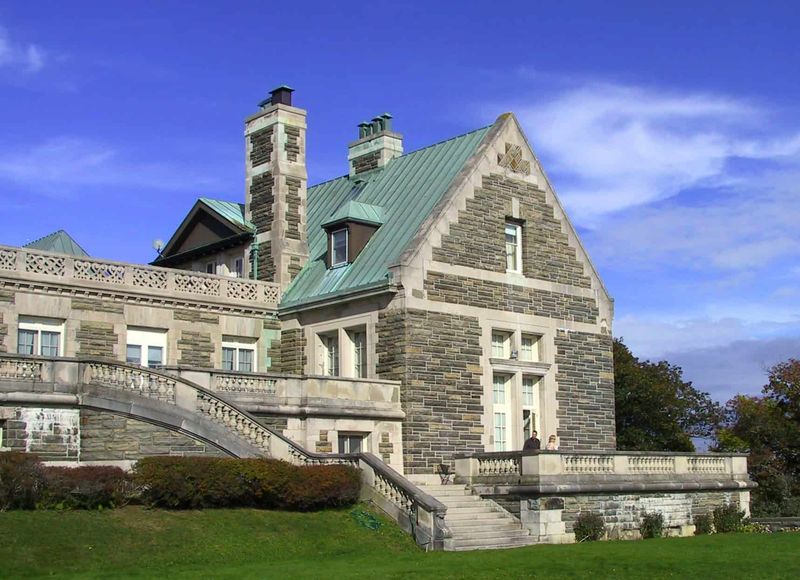
Railroad magnate E.H. Harriman created this mountaintop estate between 1905 and 1909, positioning his 100,000-square-foot mansion at the summit of a 40,000-acre wilderness preserve. The massive brick structure with limestone trim combines Renaissance and Federal architectural elements in a unique T-shaped design.
Unlike Newport’s showplaces, Arden House emphasizes integration with its natural setting. The central courtyard brings mountain views and fresh air into the heart of the mansion, while terraces offer panoramic vistas across the Hudson Highlands.
Harriman’s widow later donated the estate to Columbia University for use as a conference center. The property changed hands several times before becoming the current Chinese-owned educational retreat center. Though rarely open to the public, Arden House represents an important architectural bridge between Gilded Age excess and the more nature-focused country estates that followed.
16. Rosecliff – Oelrichs Family, Newport, RI
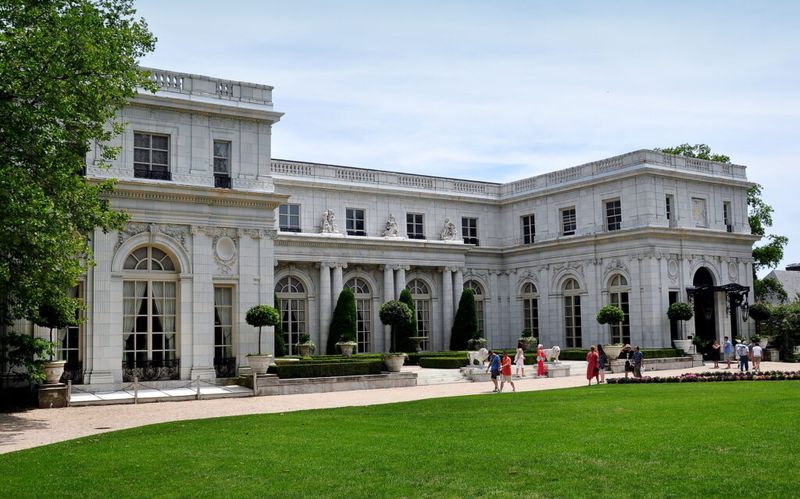
Theresa Fair Oelrichs, a silver heiress from Nevada, commissioned this gleaming white terracotta and brick mansion in 1899, modeling it after the Grand Trianon at Versailles. Architect Stanford White created Newport’s most perfect setting for entertaining, featuring the largest ballroom in Newport with 40-foot ceilings and mirrored walls.
Unlike darker Victorian mansions, Rosecliff embraces light with its bright interiors and expansive ocean views. Mrs. Oelrichs hosted legendary parties here, including her famous “Bal Blanc” where guests dressed entirely in white amid thousands of white roses.
Hollywood discovered Rosecliff’s photogenic qualities decades ago. The mansion has appeared in films like “The Great Gatsby” (1974), “True Lies,” and “27 Dresses.” Today, the Preservation Society of Newport County maintains Rosecliff, which remains Newport’s most popular mansion for weddings and special events.


